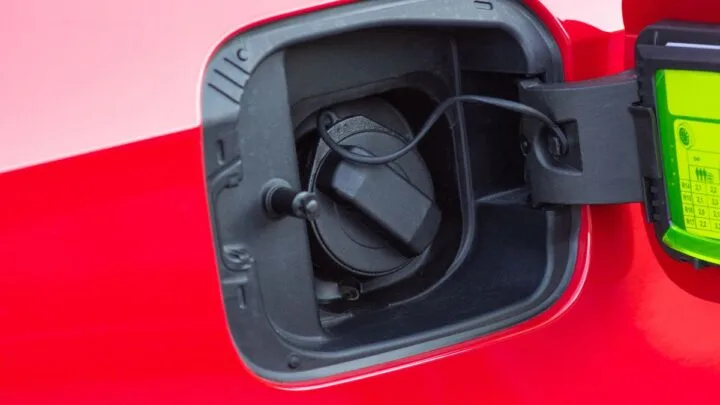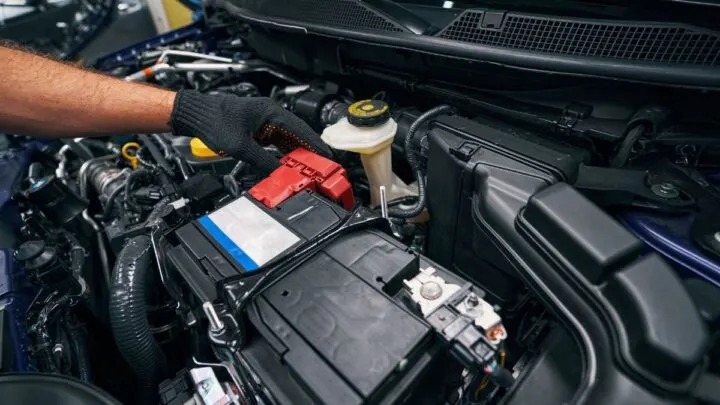Unlike old times when your car would surprisingly fail in the middle of the road, modern cars have sophisticated electronics to ensure that such instances are behind us.
One such feature is the check engine light, which illuminates as a blink or a constant light depending on the extent of the problem.
It’s an excellent feature you shouldn’t neglect for your good. However, the check engine light doesn’t tell you specifically where the problem is; you need some expertise to decode its message.
Luckily for you, here are 12 common reasons why it may come on even if your car is seemingly still running fine.
Oxygen Sensor Failure
Today’s automobiles have a wide range of technology-based sensors and actuators that provide real-time information and control of various components within the car.
These sensors determine the conditions necessary for a vehicle’s optimal performance and efficiency.
One such component is the oxygen sensor – a part of your vehicle’s emission control system.
Its role is to determine the composition of your car’s exhaust gas and transmit the information to the onboard electronics for the best engine performance.
It lets the computer know if the burning fuel has too much or too little oxygen.
If it fails, the engine computer won’t set the air-fuel ratio accordingly, leading to poor fuel economy or engine performance. As a result, the check engine light comes on when this sensor fails.
However, since the check engine light may come on for myriad other reasons, having a mechanic check it out is important.
They will run special diagnostic equipment and rely on the information on your computer to know the exact cause.
Furthermore, neglecting the check engine light is dangerous for your car. Look out for these signs that your oxygen sensor might have gone bad:
- Poor fuel economy
- Rotten egg smell (sulfur) from the exhaust
- Higher emission levels
- Black smoke from the exhaust
- Your vehicle’s catalytic converter fails
- Engine misfires and rough idling
Oxygen sensors do not last for more than 100,000 miles depending on their quality and material.
When you experience the above signs and your check engine light is on, rush immediately to a mechanic for repairs.
If they study your car’s computer and determine the problem is due to a faulty sensor, replace it before heading out.
An oxygen sensor costs between $100 to $300 depending on the model and quality you desire, excluding labor costs.
So how can you prolong the life of your vehicle’s oxygen sensors? It’s simple:
- Use manufacturer-recommended grade fuel.
- Check your owner’s manual for manufacturer recommendations on fuel and additives.
- Service your vehicle as per the owner’s manual. Pay closer attention to spark plugs and air filters.
- Take your vehicle for an annual inspection.
Loose or Missing Fuel Cap
The fuel cap is part of your vehicle’s Evaporative Emission Control System (EVAP) that prevents fuel vapors from escaping into the atmosphere.
A loose gas cap is one of the primary reasons the check engine light comes on.
Every now and then, we may end up forgetting to replace the gas cap after refueling. Other times, it may be cracked or broken, thus taking you some time before discovering so.
Therefore, if you see the check engine light notification and you suspect it’s the gas cap, the best thing before going to a mechanic would be to do a manual inspection yourself.
Go with a flashlight and shine it onto the gas cap. Do you see any cracks, tears, or chips?
If so, just replace the gas cap. Most are universal and affordable; thus, you’re better off with a good cap and better fuel economy.
If you can’t ascertain from your spotlight inspection that it has cracks, it might be that it is loose. Untighten it completely, and insert it into the gas tank filler tube.
Rotate it clockwise until you hear it click in place. You should consider replacing it as soon as possible if it doesn’t.
If a faulty gas cap caused the check engine light, it should go off after driving for several minutes.

Faulty Spark Plugs
Spark plugs are essential in internal combustion engines as they provide the spark that ignites the fuel.
They get the spark through wires from the ignition coil, and a failure of either component causes the check engine light to come on.
As such, they’re programmed to send electrical signals at preset times, and failure to do so leads to:
- Sluggish or slow acceleration
- Misfiring of the engine accompanied by sputtering or misfiring
- Poor fuel economy
- Delay in power delivery causing your vehicle to have a delayed response
- Difficulty starting the vehicle
- Rough idling
It would be best if you replaced your spark plugs according to the manufacturer’s recommendations.
In this way, you’ll save yourself from costly repairs.
You can typically replace it every 80,000 miles as part of the manufacturer’s recommended preventive maintenance.
Failed Catalytic Converter
The widespread use of catalytic converters started in1975 as automakers aimed to comply with the United States Environmental Protection Agency’s regulations.
They are part of your vehicle’s EVAP system and are located between the engine and muffler of your exhaust pipe.
A catalytic converter’s role is to convert toxic substances found in exhaust gases into less-toxic pollutants, such as carbon dioxide and water through a redox catalytic reaction.
These pollutants include hydrocarbons, nitrogen dioxide, nitric oxide, and carbon monoxide, among others.
And inside the catalytic converter is a honeycomb mesh made of platinum, rhodium, or palladium. Burnt gases from the engine flow through this mesh and undergo reduction or oxidation to less toxic gases.
Here’s how the catalysts work:
Oxidation catalysts: Change carbon monoxide to carbon dioxide by adding oxygen molecules.
Reduction catalysts: Removes oxygen molecules from the toxic nitrogen oxides to create safer nitrogen and oxygen gases.
Some of the most noticeable signs of a faulty converter include:
- Challenges accelerating
- A noticeable reduction in your vehicle’s fuel economy
- An increase in toxic emissions
It can be challenging to tell that your catalytic converter is broken since its signs of failure are similar to those of other engine problems.
So, it’s in your best interest to visit a mechanic for diagnosis when you see the check engine light.
It may be an indication of more significant underlying problems within your car.
Also, perform regular maintenance to keep the converters in excellent working condition, since they sometimes get clogged.
Mass Airflow Sensor (MAF) Failure
The mass airflow (MAF) sensor measures the amount of air entering the internal combustion engine and relays the information to the engine control unit (ECU).
This information is crucial for the ECU to balance the right amount of fuel to the engine. Any deviation in the air intake indicates a defective MAF and generally leads to poor engine performance.
Moreover, the sensor can get damaged as a result of the malfunctioning of other components.
For example, poor installation or use of collapsed air filters deteriorates the MAF causing the engine to fail to start.
If you see a check engine light on the dashboard, look out for these signs. Together they indicate that the cause of the check engine light is a failing mass airflow sensor.
- The engine stalls sometime after starting
- The engine struggles, drags, or hesitates while idling or under load
- The engine is hard to start
- Extremely lean or rich idling
- Lack of power and poor acceleration
- The altered shifting pattern of automatic transmission
Since the mass airflow sensor is a crucial component of your vehicle, you shouldn’t neglect it when it is broken.
Also, from the above, signs of a faulty MAF sensor are broad and may apply to other automobile problems as well.
Hence, your best move is to contact a mechanic who will study the car for the following codes:
- P0100: Mass or Volume Air Flow ‘A’ Circuit. The powertrain control module (PCM) detects a problem with the MAF sensor.
- P0101: Mass Air Flow Circuit Range/Performance. The signal from the MAF sensor is out of range.
- P0102: Mass Air Flow (MAF) Circuit Low. There’s insufficient air getting through the air filter.
- P0103: Mass or Volume Air Flow “A” Circuit High. The MAF sensor receives significantly higher air flow than is expected.
If your airflow sensor is broken, your only option is to replace it. The parts cost between $90 and $380, or even higher, depending on your vehicle’s model and year.

Presence of a Vacuum Leak
A vacuum leak is the accidental introduction of unwanted air into the engine’s intake due to a compromised gasket, hose, or other related components.
The excess air disrupts the engine’s predetermined air-to-fuel ratio, hindering the correct combustion.
To understand how it affects a vehicle’s performance, let’s look at how engine vacuums work.
During combustion, the pistons move up and down in a predetermined manner, depending on the engine configuration.
As the piston moves down during the intake stroke, it creates a vacuum or negative pressure zone, which opens the intake valves and pulls air into the respective cylinders.
This air is measured and determined by the engine’s throttle body; any introduction of lesser or more quantities affects your vehicle’s performance.
Here are symptoms of a vacuum leak:
- The check engine light comes on
- Hesitation or stalling, especially when stopping
- Rough idling
- Rough engine working with a lot of misfires
- Unfamiliar whistling or hissing sounds from the engine
Some causes of a vacuum leak include:
- Dry and worn-out vacuum hoses
- Leaking intake manifold gasket
- Leaking brake booster diaphragm
- Brittle and broken intake hoses
- Stuck exhaust gas recirculation (EGR) valves
- Faulty positive crankcase ventilation (PCV) valves
Poorly Installed Aftermarket Alarms
An aftermarket alarm can wreak havoc and cause immense damage to your vehicle if installed poorly.
It can trigger the check engine light, drain the battery, or even cause your car to fail to start correctly.
Additionally, poorly installed alarms may trigger themselves and go off at unusual times when you least expect it.
Such times include going off in the middle of the night due to strong winds, a leaf falling on the hood, or even starting a generator close to the car.
If you experience any of the above signs, you can opt to have it repaired, reinstalled, or replaced entirely.
The check engine light is just a signal to check your car; ignoring it can be fatal.
Exhaust Gas Recirculation Valve Failure
The exhaust gas recirculation (EGR) valve controls the NOx emissions from the diesel internal combustion engines.
They work by reducing the levels of oxygen in the combustion chamber in addition to absorbing heat.
Approximately 78% of the air we breathe in is nitrogen. However, under high temperatures (close to 1370°C), the nitrogen becomes reactive, blending with oxygen to form dangerous nitrogen oxides (NOx).
The EGR valve reinjects a measured amount of exhaust gases into the engines to help reduce the disastrous effects of NOx on the atmosphere.
The resulting mixture has less oxygen and burns at a lower temperature, reducing the exhaust gas’s NOx.
Over time the EGR valves fail due to the normal wear and buildup of carbon particles from the exhaust gases.
Eventually, these will clog the valve’s plunger mechanism causing it to stick open or close – which is undesirable.
Luckily, the EGR valve is cheap, costing around $125 minus labor costs.
Faulty Spark Plug Wires
Ignition cables or spark plug wires are found in some vehicles, while other manufacturers have opted for newer ignition coils.
They’re made of high durability and low resistance materials that can withstand the torrid conditions under the hood and the high voltages needed for a successful ignition.
Also, spark plug wire failure negative impacts your car’s performance.
Here are some signs of faulty spark plug wires.
- Check engine light on the dashboard
- Reduced engine power
- Rough idling
- Engine hesitation and misfiring
- Hard starting
Spark plug wires are robust and can last beyond 60,000 miles. They’re cheap and will cost you $50 without the labor costs.
However, this is subject to their quality, use and abuse, and insulation.
Additionally, replace faulty spark plug wires as soon as possible, as they can lead to more significant powertrain problems.
Dead Battery
A dying battery results in a low voltage within a vehicle. As a result, your vehicle’s computer receives a low voltage and generates an error code that triggers a check engine light.
The battery is the primary storage of energy necessary for starting your vehicle and powering its electronics. Generally, a low battery causes the low battery light to come on.
However, a low voltage supply across the various electronics will trigger the check engine light.
If a check engine light comes on when the battery is low, contact an honest mechanic for assistance.
You may overspend on other check engine light diagnoses when the problem is the low voltage battery.

Faulty Engine Coolant Temperature Sensor (CTS)
The engine coolant temperature sensor (CTS) monitors the temperature of the engine coolant.
If your engine is overheating, it’s the CTS’s role to inform you through the check engine light and simultaneously initiate measures to lower the temperature to safer levels.
Modern car engines will basically shut off if the CTS sensors fail in such a way as to protect the engine from damage.
Look out for these signs of a faulty engine coolant temperature sensor.
- Poor fuel economy
- Irregular temperature readings
- Your engine is overheating
- Black smoke from the exhaust
- Your check engine light is on
A Bad Knock Sensor
Knock sensors don’t get the attention that other sensors get pertaining to the check engine light.
Their role is to detect unusual combustion or “knocks” within the engine’s combustion chambers.
A knock creates an undesirable increase in cylinder pressure, and you can tell by a metallic pinging noise from within.
Look out for these signs of a bad knock sensor
- Your check engine light is on
- Poor engine performance
- Pinging noise from the engine
The Takeaway of Your Check Engine Light Being On
Suppose your vehicle exhibits one or two symptoms that may cause the check engine light to come on. Your best option would be to contact a mechanic to run a diagnostics.
Reason being that most check engine light causes have similar signs, such as reduced engine performance, rough idling, and black smoke from the exhaust.
On the brighter side, you can resolve most of these problems cheaply if you detect them earlier.
